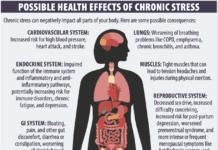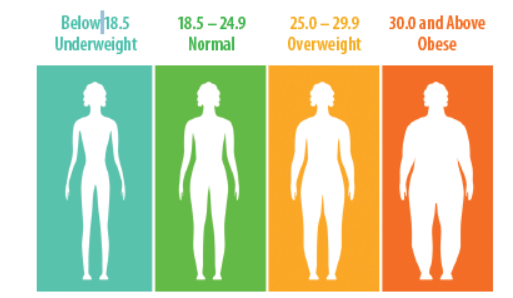Body Mass Index (BMI) is a measure of body weight adjusted for height. It is considered a better indicator of excess weight than body weight alone and is used to categorize individuals as “underweight,” “normal weight,” “overweight,” or “obese.” What does it really tell us, and how accurate is it?
Measuring Body Fat: Being overweight or obese is associated with a wide range of chronic and acute health conditions, so determining how much excess body fat a person is carrying is an important factor in caring for their overall health. There are many ways to determine how much body fat an individual has, including skinfold thicknesses, bioelectrical impedance, underwater weighing, and dual energy x-ray absorption. These measures can be expensive, intrusive, not widely available, or technically demanding. Calculating BMI provides a quick, easy, inexpensive surrogate measure of body fatness. Studies have shown BMI correlates well with results of more complex methods for assessing body fatness and with future health risks.
To calculate BMI, body weight (in kilograms) is divided by height (in meters) squared. In English measures, weight (in pounds) is divided by height (in inches) squared, then multiplied by 703. A link to an easy-to-use online BMI calculator is provided in Resources, below. The resulting number is then interpreted using a chart like the one accompanying this article.
BMI and Health: According to the Centers for Disease Control and Prevention, in general, the higher one’s BMI over 25, the higher the risk of developing a range of conditions, including diabetes, arthritis, liver disease, several types of cancer (such as those of the breast, colon, and prostate), high blood pressure (hypertension), high LDL-cholesterol, and sleep apnea. The good news is, research shows that even a small weight loss (between five and 10 percent of current weight) will help lower the risk of developing those conditions.
BMI under 18.5 has also been associated with higher mortality. There are many biases and confounding factors that make it difficult for researchers to determine the exact reasons for this association. One possibility is that very low BMI is a side effect of underlying conditions that lead to death.
Limitations: While BMI is often considered an indicator of body fatness, it actually measures excess weight, rather than excess fat. Because it uses total weight, it cannot distinguish between the mass of fat, and that of muscle and bone. A body builder, therefore, may have a high BMI even though he or she has very little body fat. Pregnancy also throws off BMI. This measure is not appropriate for infants, and BMI-for-age charts are used for growing children. For a similar BMI, older adults tend to have more body fat than younger adults, and women, on average, have greater amounts of total body fat than men.
Importantly, BMI does not provide any indication of the distribution
of fat. Visceral fat (the kind that accumulates around and
between organs) is more strongly associated with health risks than subcutaneous fat (which is under the skin), making fat distribution an important health measure. Waist circumference (or waist/hip ratio) is a simple measure of fat distribution that is sometimes used alone or in combination with BMI to assess health risk.
Like other measures of body fatness, BMI does not always predict disease or risk of disease. Someone with a BMI in the “normal weight” range can have a high disease risk (particularly if they smoke, are sedentary, have poor diet quality, or have a strong family history of cardiovascular disease). Likewise, someone with a high BMI is not necessarily destined to have cardiovascular disease (particularly if they are physically fit, avoid tobacco products, and lack a genetic predisposition).
BMI Bonuses: Most of what we know about obesity-related health risks comes from research that compared the BMI of participants to various outcomes. BMI is valuable to researchers and public health experts for tracking weight trends in populations across time and geographic regions and has been repeatedly associated with health outcomes in populations. While BMI does not provide information on body composition, it uses easily obtained, readily available measures (height and weight) and is therefore a valuable screening tool for identifying potential weight-associated health problems in individuals.
Use a calculator like the one provided in Resources, below, to learn your BMI, and follow these tips:
- Talk to a healthcare provider if your BMI is outside the “normal” range.
- If your BMI is 25 or higher, aim to lose at least five to 10 percent of your weight, especially if you have other risk factors, like high blood pressure or diabetes.

























BMI is a lazy way for your doctor to learn and track data on your weight. BMI is a waste of time for anyone who tries to build muscle (vs lose fat). Terrible measurement. Why does it keep getting promoted? Oh yes, because it is easy.